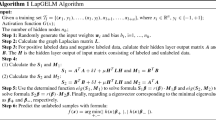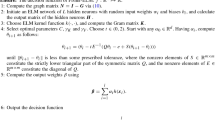Abstract
Two extreme learning machine (ELM) frameworks are proposed to handle supervised and semi-supervised classifications. The first is called lagrangian extreme learning machine (LELM), which is based on optimality conditions and dual theory. Then LELM is extended to semi-supervised setting to obtain a semi-supervised extreme learning machine (called Lap-LELM), which incorporates the manifold regularization into LELM to improve performance when insufficient training information is available. In order to avoid the inconvenience caused by matrix inversion, Sherman-Morrison-Woodbury (SMW) identity is used in LELM and Lap-LELM, which leads to two smaller sized unconstrained minimization problems. The proposed models are solvable in a space of dimensionality equal to the number of sample points. The resulting iteration algorithms converge globally and have low computational burden. So as to verify the feasibility and effectiveness of the proposed method, we perform a series of experiments on a synthetic dataset, near-infrared (NIR) spectroscopy datasets and benchmark datasets. Compared with the traditional methods, experimental results demonstrate that the proposed methods achieve better performances than the traditional supervised and semi-supervised methods in most of considered datasets.





Similar content being viewed by others
References
Huang G, Zhu QY, Siew CK (2006) Extreme learning machine: theory and applications. Neurocomputing 70(1):489–501
Huang G, Ding XJ, Zhou HM (2010) Optimization method based extreme learning machine for classification. Neurocomputing 74:155–163
Huang G, Huang G, Song S, You KY (2015) Trends in extreme learning machines: a review. Neural Netw 61:32–48
Yang L, Zhang S (2017) A smooth extreme learning machine framework. J Intell Fuzzy Syst 33(6):3373–3381
Yang L, Zhang S (2016) A sparse extreme learning machine framework by continuous optimization algorithms and its application in pattern recognition. Eng Appl Artif Intel 53(C):176– 189
Wang Y, Cao F, Yuan Y (2011) A study on effectiveness of extreme learning machine. Neurocomputing 74(16):2483–2490
Wang G, Lu M, Dong YQ, Zhao XJ (2016) Self-adaptive extreme learning machine. Neural Comput Appl 27(2):291–303
Zhang W, Ji H, Liao G, Zhang Y (2015) A novel extreme learning machine using privileged information. Neurocomputing 168(C):823–828
Zhang Y, Wu J, Cai Z, Zhang P, Chen L (2016) Memetic extreme learning machine. Pattern Recogn 58(C):135–148
Ding XJ, Lan Y, Zhang ZF, Xu X (2017) Optimization extreme learning machine with ν regularization. Neurocomputing
Vapnik, Vladimir N (2002) The nature of statistical learning theory. IEEE Trans Neural Netw 8(6):1564–1564
Belkin M, Niyogi P (2004) Semi-supervised learning on riemannian manifolds. Mach Learn 56(1-3):209–239
Belkin M, Niyogi P, Sindhwani V (2006) Manifold regularization: a geometric framework for learning from labeled and unlabeled examples. JMLR.org
Xiaojin Z (2006) Semi-supervised learning literature sur-vey. Semi-Supervised Learning Literature Sur-vey, Technical report, Computer Sciences. University of Wisconsin-Madisoa 37(1):63–77
Chapelle O, Sindhwani V, Keerthi SS (2008) Optimization techniques for semi-supervised support vector machines. J Mach Learn Res 9(1):203–233
Wang G, Wang F, Chen T, Yeung DY, Lochovsky FH (2012) Solution path for manifold regularized semisupervised classification. IEEE Trans Syst Man Cybern Part B Cybern A Publ IEEE Syst Man Cybern Soc 42 (2):308
Melacci S, Belkin M (2009) Laplacian support vector machines trained in the primal. J Mach Learn Res 12(5):1149–1184
Chen WJ, Shao YH, Xu DK, Fu YF (2014) Manifold proximal support vector machine for semi-supervised classification. Appl Intell 40(4):623–638
Deng W, Zheng Q, Chen L (2009) Regularized extreme learning machine. In: IEEE Symposium on computational intelligence and data mining, 2009. CIDM ’09. IEEE, pp 389–395
Iosifidis A, Tefas A, Pitas I (2014) Semi-supervised classification of human actions based on neural networks. In: International conference on pattern recognition, vol 15. IEEE, pp 1336– 1341
Huang G, Song S, Gupta JND, Wu C (2014) Semi-supervised and unsupervised extreme learning machines. IEEE Trans Cybern 44(12):2405
Zhou Y, Liu B, Xia S, Liu B (2015) Semi-supervised extreme learning machine with manifold and pairwise constraints regularization. Neurocomputing 149(PA):180–186
Liu B, Xia SX, Meng FR, Zhou Y (2016) Manifold regularized extreme learning machine. Neural Comput Applic 27(2):255–269
Mangasarian O, Musicant L, David R (2001) Lagrangian support vector machines. J Mach Learn Res 1(3):161–177
Balasundaram S, Tanveer M (2013) On lagrangian twin support vector regression. Neural Comput Appl 22(1):257–267
Tanveer M, Shubham K, Aldhaifallah M, Nisar KS (2016) An efficient implicit regularized lagrangian twin support vector regression. Appl Intell 44(4):1–18
Shao YH, Chen WJ, Zhang JJ, Wang Z, Deng NY (2014) An efficient weighted lagrangian twin support vector machine for imbalanced data classification. Pattern Recogn 47(9):3158– 3167
Balasundaram S, Gupta D, Prasad SC (2016) A new approach for training lagrangian twin support vector machine via unconstrained convex minimization. Appl Intell 46(1):1–11
Balasundaram S, Gupta D (2014) On implicit lagrangian twin support vector regression by newton method International. J Comput Intell Syst 7(1):50–64
Tanveer M, Shubham K (2017) A regularization on lagrangian twin support vector regression. Int J Mach Learn Cybern 8(3):807–821
Balasundaram S, Gupta D (2014) Training lagrangian twin support vector regression via unconstrained convex minimization. Knowl-Based Syst 59(59):85–96
Tanveer M (2015) Newton method for implicit lagrangian twin support vector machines. Int J Mach Learn Cybern 6(6):1029–1040
Shao YH, Hua XY, Liu LM, Yang ZM, Deng NY (2015) Combined outputs framework for twin support vector machines. Appl Intell 43(2):424–438
Bertsekas DP (1997) Nonlinear programming. J Oper Res Soc 48(3):334–334
Acknowledgements
This work was supported in part by National Natural Science Foundation of China (No11471010) and Chinese Universities Scientific Fund.
Author information
Authors and Affiliations
Corresponding author
Rights and permissions
About this article
Cite this article
Ma, J., Wen, Y. & Yang, L. Lagrangian supervised and semi-supervised extreme learning machine. Appl Intell 49, 303–318 (2019). https://doi.org/10.1007/s10489-018-1273-4
Published:
Issue Date:
DOI: https://doi.org/10.1007/s10489-018-1273-4




